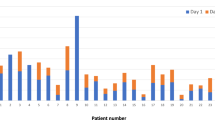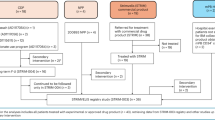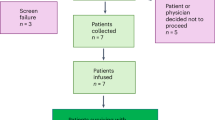Abstract
Autologous stem cell transplantation using unprocessed, G-CSF-mobilized whole blood (WB) is a simple, cost-reducing procedure and supports high-dose chemotherapy regimens not exceeding 72 h. Thereafter, clonogenic capacity rapidly decreases if routine anticoagulants are used for storage. In order to increase clinical applicability, we investigated the requirements for optimal preservation of unprocessed WB for 7 days. During storage at 22°C in CPDA-1, a decrease in pH was noted, which was at least partially responsible for the low recovery of clonogenic cells. Subsequently, WB cells were stored in various cell culture media (RPMI 1640, α-MEM, X-VIVO15, CellGro SCGM and Leibovitz's L15 medium) containing either serum, serum-free substitutes or no additives. Leibovitz's L15 showed significantly better CFU-GM recoveries than the other media. Using a calcium-free modification of L15 medium (added 3:10 to WB), 94 ± 24% of CD34+ cells, 41 ± 14% of BFU-E, 56 ± 17% CFU-GM and 90 ± 14% of LTC-IC were preserved during storage for 7 days at 22°C. Storage at 4°C was also feasible, but showed less optimal recoveries of 52 ± 29% (CD34), 32 ± 10% (BFU-E), 13 ± 7% (CFU-GM) and 58 ± 9% (LTC-IC). The expression of CD38, Thy-1, c-kit, AC133, L-selectin and CXCR4 on CD34-positive cells remained unchanged. In conclusion, a modified Leibovitz's L15 medium better meets the metabolic requirements of a high-density cell culture and allows safe storage of G-CSF mobilized WB for at least 7 days. The results encourage further exploration of WB transplants stored for 7 days for clinical use. Bone Marrow Transplantation (2001) 28, 145–155.
This is a preview of subscription content, access via your institution
Access options
Subscribe to this journal
Receive 12 print issues and online access
$259.00 per year
only $21.58 per issue
Buy this article
- Purchase on SpringerLink
- Instant access to full article PDF
Prices may be subject to local taxes which are calculated during checkout



Similar content being viewed by others
References
Uyl-de Groot CA, Richel DJ, Rutten FF . Peripheral blood progenitor cell transplantation mobilised by r-metHuG-CSF (filgrastim); a less costly alternative to autologous bone marrow transplantation Eur J Cancer 1994 30A: 1631–1635
Uyl-de Groot CA, Ossenkoppele GJ, Buijt I, Huijgens PC . Costs of peripheral blood progenitor cell transplantation using whole blood mobilised by filgrastim as compared with autologous bone marrow transplantation in non-Hodgkin's lymphoma Pharmacoeconomics 1999 15: 305–311
Siena S, Schiavo R, Pedrazzoli P, Carlo-Stella C . Therapeutic relevance of CD34 cell dose in blood cell transplantation for cancer therapy J Clin Oncol 2000 18: 1360–1377
O'Flaherty E, Cebon J, Grigg AP . Viability and quantification of progenitor cells in venesected blood from patients receiving escalated-dose epirubicin and cyclophosphamide with G-CSF for lymphoma: potential role in further increasing dose-intensity Leuk Lymphoma 1997 27: 343–349
Vanasek J, Filip S, Medkova V et al. Mobilization of peripheral blood progenitor cells (PBPC) through a combination of chemotherapy and G-CSF in breast cancer patients and a possibility of unprocessed whole blood collection Bone Marrow Transplant 1998 21: 123–126
Weaver A, Testa NG . Stem cell factor leads to reduced blood processing during apheresis or the use of whole blood aliquots to support dose-intensive chemotherapy Bone Marrow Transplant 1998 22: 33–38
Corato A, Ambrosetti A, Rossi B et al. Transplantation potential of peripheral whole blood primed by VACOP-B chemotherapy plus filgrastim (r-metHuG-CSF) in patients with aggressive non-Hodgkin's lymphoma J Hematother Stem Cell Res 2000 9: 673–682
Ossenkoppele GJ, Schuurhuis GJ, Jonkhoff AR et al. High-dose melphalan with re-infusion of unprocessed, G-CSF-primed whole blood is effective and non-toxic therapy in multiple myeloma Eur J Cancer 1996 32A: 2058–2063
Jonkhoff AR, de Kreuk AM, Hendriks EC et al. G-CSF stimulated whole blood transplantation: clinical data of 47 relapsed NHL patients and in vitro data of prolonged storage of whole blood up to 7 days Blood 1999 94: (Suppl. 1) 339b (Abstr.)
Woll PJ, Thatcher N, Lomax L et al. Use of hematopoietic progenitors in whole blood to support dose-dense chemotherapy: a randomized phase II trial in small-cell lung cancer patients J Clin Oncol 2001 19: 712–719
Ossenkoppele GJ, Schuurhuis GJ, Jonkhoff AR et al. G-CSF (filgrastim)-stimulated whole blood kept unprocessed at 4°C does support a BEAM-like regimen in bad-risk lymphoma Bone Marrow Transplant 1996 18: 427–431
Pettengell R, Woll PJ, O'Connor DA et al. Viability of haemopoietic progenitors from whole blood, bone marrow and leukapheresis product: effects of storage media, temperature and time Bone Marrow Transplant 1994 14: 703–709
Drouet X, Douay L, Giarratana MC et al. Human liquid bone marrow culture in serum-free medium Br J Haematol 1989 73: 143–147
Kohsaki M, Yanes B, Ungerleider JS, Murphy Jr MJ . Non-frozen preservation of committed hematopoietic stem cells from normal human bone marrow Stem Cells 1981 1: 111–123
Mangalik A, Robinson WA, Drebing C et al. Liquid storage of bone marrow Exp Hematol 1979 7: (Suppl. 5) 76–94
Delforge A, Ronge-Collard E, Stryckmans P et al. Granulocyte–macrophage progenitor cell preservation at 4°C Br J Haematol 1983 53: 49–54
Lasky LC, McCullough J, Zanjani ED . Liquid storage of unseparated human bone marrow. Evaluation of hematopoietic progenitors by clonal assay Transfusion 1986 26: 331–334
Jestice HK, Scott MA, Ager S et al. Liquid storage of peripheral blood progenitor cells for transplantation Bone Marrow Transplant 1994 14: 991–994
Folkman J, Moscona A . Role of cell shape in growth control Nature 1978 273: 345–349
Lee YH, Han JY, Choi AH et al. The alterations of the activities of coagulation inhibitors and fibrinolytic factors in stored cord blood could affect the yield of progenitor cells during processing J Hematother 1999 8: 653–657
de Kreuk AM, Hendriks EC, Zevenbergen A et al. Reproducibility of CFU-GM enumeration in G-CSF stimulated whole blood using three different methods Haematologica 1999 84: (Suppl. 1) 73 (Abstr.)
Eaves C, Lambie K . Atlas of Human Hematopoietic Colonies Stem Cell Technologies: Vancouver 1995
Thijsen SF, Schuurhuis GJ, van Oostveen JW et al. Mobilization of hematopoietic progenitors in patients with chronic myeloid leukemia Bone Marrow Transplant 1997 20: 835–842
Sutherland HJ, Lansdorp PM, Henkelman DH et al. Functional characterization of individual human hematopoietic stem cells cultured at limiting dilution on supportive marrow stromal layers Proc Natl Acad Sci USA 1990 87: 3584–3588
Taswell C . Limiting dilution assays for the determination of immunocompetent cell frequencies. I. Data analysis J Immunol 1981 126: 1614–1619
Fazekas de St Groth S . The evaluation of limiting dilution assays (review) J Immunol Meth 1982 49: R11–R23
Schuurhuis GJ, Monnee-van Muijen M, Oberink JW et al. Large populations of non-clonogenic early apoptotic CD34 positive cells are present in frozen–thawed peripheral blood stem cell transplants Bone Marrow Transplant 2001 27: 487–498
Sutherland DR, Anderson L, Keeney M et al. The ISHAGE guidelines for CD34+ cell determination by flow cytometry. International Society of Hematotherapy and Graft Engineering J Hematother 1996 5: 213–226
Cipolleschi MG, Dello Sbarba P, Olivotto M . The role of hypoxia in the maintenance of hematopoietic stem cells Blood 1993 82: 2031–2037
Robinson WA, Drebing C, Mahmood T et al. Recovery of CFU-C after freezing of normal and leukemic human bone marrow Exp Hematol 1979 7: (Suppl. 5) 27–37
Abrams RA, Polacek L, Buck P . Postcryopreservation growth of human CFU-GM: sequential examination of methodologic factors Exp Hematol 1985 13: 1089–1093
Rowley SD, Piantadosi S, Santos GW . Correlation of hematologic recovery with CFU-GM content of autologous bone marrow grafts treated with 4-hydroperoxycyclophosphamide. Culture after cryopreservation Bone Marrow Transplant 1989 4: 553–558
Nicol A, Nieda M, Donaldson C et al. Analysis of cord blood CD34+ cells purified after cryopreservation Exp Hematol 1995 23: 1589–1594
Beaujean F, Bourhis JH, Bayle C et al. Successful cryopreservation of purified autologous CD34+ cells: influence of freezing parameters on cell recovery and engraftment Bone Marrow Transplant 1998 22: 1091–1096
Balint B, Ivanovic Z, Petakov M et al. The cryopreservation protocol optimal for progenitor recovery is not optimal for preservation of marrow repopulating ability Bone Marrow Transplant 1999 23: 613–619
McAdams TA, Miller WM, Papoutsakis ET . Variations in culture pH affect the cloning efficiency and differentiation of progenitor cells in ex vivo haemopoiesis Br J Haematol 1997 97: 889–895
Hevehan DL, Papoutsakis ET, Miller WM . Physiologically significant effects of pH and oxygen tension on granulopoiesis Exp Hematol 2000 28: 267–275
Eagle H, Barban S, Levy M, Schulze HO . The utilization of carbohydrates by human cell cultures J Biol Chem 1958 223: 551–558
Robinson EA, Kalckar HM, Troedsson H, Sanford K . Metabolic inhibition of mammalian uridine diphosphate galactose 4-epimerase in cell cultures and in tumor cells J Biol Chem 1966 241: 2737–2745
Leibovitz A . The growth and maintenance of tissue-cell cultures in free gas exchange with the atmosphere Am J Hyg 1963 78: 173–180
Baugh CL, Bowersock RK . Growth responses of cell cultures in a galactose medium Life Sci 1974 15: 1955–1960
Barngrover D, Thomas J, Thilly WG . High density mammalian cell growth in Leibovitz bicarbonate-free medium: effects of fructose and galactose on culture biochemistry J Cell Sci 1985 78: 173–189
Burger SR, Hubel A, McCullough J . Development of an infusible-grade solution for non-cryopreserved hematopoietic cell storage Cytotherapy 1999 1: 123–133
Craig W, Kay R, Cutler RL, Lansdorp PM . Expression of Thy-1 on human hematopoietic progenitor cells J Exp Med 1993 177: 1331–1342
Murray L, Chen B, Galy A et al. Enrichment of human hematopoietic stem cell activity in the CD34+Thy−1+Lin− subpopulation from mobilized peripheral blood Blood 1995 85: 368–378
Sogo S, Inaba M, Ogata H et al. Induction of c-kit molecules on human CD34+/c-kitlow cells: evidence for CD34+/c-kitlow cells as primitive hematopoietic stem cells Stem Cells 1997 15: 420–429
Sakabe H, Ohmizono Y, Tanimukai S et al. Functional differences between subpopulations of mobilized peripheral blood-derived CD34+ cells expressing different levels of HLA-DR, CD33, CD38 and c-kit antigens Stem Cells 1997 15: 73–81
Ortiz M, Wine JW, Lohrey N et al. Functional characterization of a novel hematopoietic stem cell and its place in the c-Kit maturation pathway in bone marrow cell development Immunity 1999 10: 173–182
Yin AH, Miraglia S, Zanjani ED et al. AC133, a novel marker for human hematopoietic stem and progenitor cells Blood 1997 90: 5002–5012
de Wynter EA, Buck D, Hart C et al. CD34+AC133+ cells isolated from cord blood are highly enriched in long-term culture-initiating cells, NOD/SCID-repopulating cells and dendritic cell progenitors Stem Cells 1998 16: 387–396
Dercksen MW, Gerritsen WR, Rodenhuis S et al. Expression of adhesion molecules on CD34+ cells: CD34+ L-selectin+ cells predict a rapid platelet recovery after peripheral blood stem cell transplantation Blood 1995 85: 3313–3319
Peled A, Petit I, Kollet O et al. Dependence of human stem cell engraftment and repopulation of NOD/SCID mice on CXCR4 Science 1999 283: 845–848
Zanjani ED, Flake AW, Almeida-Porada G et al. Homing of human cells in the fetal sheep model: modulation by antibodies activating or inhibiting very late activation antigen-4-dependent function Blood 1999 94: 2515–2522
Acknowledgements
This study was supported by research funding from Acordis GmbH, Obernburg, Germany.
Author information
Authors and Affiliations
Rights and permissions
About this article
Cite this article
de Kreuk, A., Jonkhoff, A., Zevenbergen, A. et al. Storage of unprocessed G-CSF-mobilized whole blood in a modified Leibovitz's L15 medium preserves clonogenic capacity for at least 7 days. Bone Marrow Transplant 28, 145–155 (2001). https://doi.org/10.1038/sj.bmt.1703127
Received:
Accepted:
Published:
Issue date:
DOI: https://doi.org/10.1038/sj.bmt.1703127



